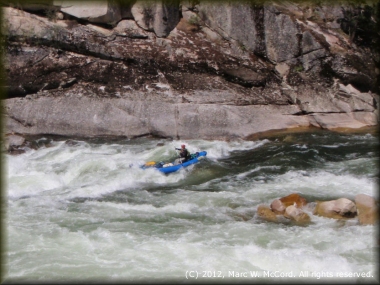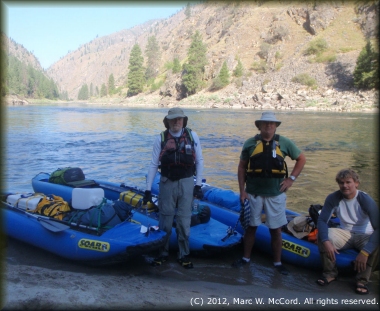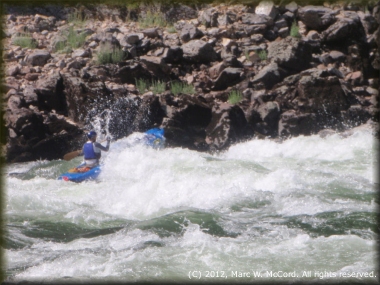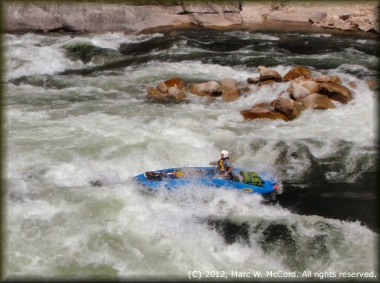|
Most canoeists and kayakers, as well as many rafters, who enjoy the thrills of big water rivers prepare in advance of their pursuits by taking swiftwater rescue classes to learn the skills necessary for surviving trouble on rivers designated Class III and higher. Periodic refresher courses are necessary to maintain knowledge and skills because either we do not paddle often enough or we are not in situations where we have to put our training and skills to use. Failure to maintain proficiency can lead to unwanted and unintended results when the chips are down and a paddler finds himself or herself in the water on a raging river. The purpose of this story is to relate what can happen and how to avoid an unhappy ending.

Tom entering a big rapid in his SOAR S16
In July, 2012, my friend Randy called to say he had just acquired a permit for Idaho's Main Salmon River and was preparing to do a 7-day trip from Corn Creek Access to Carey Creek Access, a GPS-measured trip of 84 miles on Class II to IV whitewater. Randy had been there once last year, and the other six in the group had never paddled the river, but are all very experienced whitewater open boaters with substantial experience and solid skills. It was an opportunity of a lifetime, and in just a few days we made the preparations and departed Texas for Idaho by car. Randy had gotten a cancellation permit and had ten days notice before the trip departure date (14 days before our launch date.) I had four days notice, but wanting to escape the hot, very dry summer in Texas I was ready to go in one day. I contacted two other friends with whom I frequently paddle to see if they wanted to go, and they did.
Randy and his wife Libbi were rowing oarboat rafts, Carey was paddling a whitewater kayak, Carey's son Josh was riding on the larger of the two rafts, Stan was paddling his SOAR S14 inflatable canoe, Tom and I were paddling our SOAR S16's. Over the years most of us had been involved in many river rescues because if you paddle enough whitewater, then you WILL be in a rescue situation sooner or later. It is just inevitable. For the record, most of those situations did not involve people within our own group - we have frequently come upon situations where others got into trouble and needed some additional assistance. The many hours of training, re-training and practice have paid off numerous times in successful rescues. I have never been involved in a rescue where significant injury or death occurred, and it is always my goal to maintain that record if at all possible.

Tom, Marc and Stan with our SOAR Inflatable Canoes
The Main Salmon was running at about 5,500 cfs on our launch date and remained fairly steady throughout our trip. That level is considered to be "low runnable" by river rangers and experienced paddlers who know the river well. It was still high enough for the jetboats to ply its waters going upriver and downriver, and at no time did we ever encounter any boulders that were not avoidable by good boat control, even in the most rigorous rapids. The water conditions were what I would consider ideal for people in smaller craft than giant rafts.
It did not take long before the fun began - the Main Salmon has numerous significant rapids, though most were in the Class II range. On the first day we ran 5 rapids ranging from Class II to III+ without incident. We nailed each of them and enjoyed doing it. On day 2 we ran two small Class II rapids before getting to the gnarly Black Canyon Rapid just below the site of the former Salmon Falls Rapid, which is nearly non-existent today because of blasting that tamed the Class III to III+ drop (we barely even knew it was there!) But, Black Canyon Rapid certainly made its presence known. Scouting from above, it did not look like anything of great significance, but once in the rapid a paddler can see just how challenging it can be. Most of us ran Black Canyon without too much trouble, but a hole/rock/wave combination flipped Tom's SOAR and sent him swimming. It was no big deal - we have all swum rapids before and Tom held onto his paddle as he rode out the big waves trying to get to where he could extract himself from the water.
Randy, paddling his cataraft and having led the trip, was downriver first, and he responded immediately to Tom. I was the last to run, just behind Tom, so after my run I joined Randy as he steered Tom's boat to a quietwater eddy on river left. Just as we were getting Tom and his boat guided into the eddy an unseen but very strong rip current caught Tom and sucked him down against an undercut boulder. We saw his head go under just as we were reaching to pull him onto the raft. Tom got a deep breath of air and swam away from the boulder a few yards to where he surfaced and grabbed the raft. We proceeded to move Tom and the boat downriver below the boulders to where we beached, flipped the SOAR, got back in our boats and went on our merry way, wetter than before, but safe and uninjured having survived Tom being swept underwater against that boulder in what appeared to be calm water.
It left Randy more shaken than it did either Tom or me because he had steered Tom into that situation with none of us realizing the potential threat it posed. There were just no visible signs of that current and its nature to pull objects away from the beach and under the boulder toward the middle of the river. Rip currents are known beach hazards on oceans, but few people think of them also being found on rivers. We discussed what happened and all three of us agreed that we did not see any indications of a problem at the time we moved Tom and his flipped boat into that situation. We learned a valuable lesson and walked away with "no harm, no foul."
Day Three turned out to be very different. We had some great rapids, but nothing too challenging, and we made great time downriver. We had three Class III rapids (Bailey's Creek, Five Mile and Split Rock) that were a blast, especially in our SOARs. These boats handle rough water so fantastically that they can give you a false sense of security causing you to relax when perhaps you should be a little more on edge, but Day Three gave us no particular problems. The real challenges were still ahead, and we knew it because we had all carefully studied the river in printed guides and on YouTube videos so that we would know what to expect. |
|
Day Four turned out to be a lot different from the trip up to this point. Almost immediately after launching from our Upper Yellowpine Campsite we ran into a duck - a Big Mallard - the second most challenging rapid on the river. It was a solid Class IV, possibly Class IV+, and it seemed even more challenging during the run than what it looked to be upon scouting. Looking at it from high on the rocks above on river left we arrived to find several other groups who had gotten there ahead of us and who were staring in wonderment at what was about to beset them. After about a half hour of carefully surveying the lay of the rapid we knew where we wanted to run. It was full of holes, boulders and huge waves. There were also some "sneak routes", if you can truly call them that, which avoided the meat of the rapid and most in our group chose discretion over valor.
Randy led the way and pulled off a run that dazzled some of the professional guides who were watching. They later quizzed him on how he managed to take his cat on the right side of a huge wrap rock boulder that seemed to be searching for a boat to bend. Randy is a very experienced canoeist and rafter who was on his game and he managed what many thought was a "miracle run" that avoided all the rocks. Next, Libbi and Josh ran the rapid in the big raft and eddied out to the right in the center of the river, but the eddy was so strong that they had a lot of work getting the raft back into the current and on downriver. Kerry plunged head on into the teeth of that duck and nailed his run in his Dagger Crossfire kayak. Stan took the same line that Libbi took in the big raft and pulled into the same eddy.

Stan a big rapid in his SOAR S14
Seeing how the eddy had grabbed both the big raft and Stan's 14-foot SOAR I determined to avoid the big hole at the bottom, yet ride the right edge of the eddyline through the bottom of the drop avoiding getting caught in that eddy and having to spend a lot of energy getting my loaded SOAR back into the current. I entered the run exactly as I intended, but a cross current spun we sideways near the top, and I was unable to affect a move to get back forward, so I turned backward to avoid running the big waves sideways and was cruising through the rapid at 13.9 mph on my GPS, oblivious to the world around me and just trying to keep the boat straight and moving.
Suddenly, I dropped down into the deep hole and as I was emerging a huge wave slammed my right shoulder and knocked me out of my 16-foot SOAR, which remained upright. I never saw it coming and had no chance to get a breath of air. I hit the water clinging to my Z-stick (those things are too expensive to lose!) and when I tried to surface my head hit the bottom on my boat, which was now directly on top of me. Three more times I tried to surface, but each time I hit the bottom of the boat. I opened my eyes, located the boat and daylight beside it, then swam away by a few feet and popped to the surface exhausted, out of breath and unable to do anything to help myself because I had absolutely no energy. I have no idea how long I was underwater or how far downriver I moved, but it seemed like an eternity, though it was probably not more than 30-40 seconds.
Seeing that I was struggling to get a breath and unable to swim, Stan came to me, grabbed my PFD shoulder straps and dragged me to the riverbank where he deposited me on rocks. I sat there at least ten minutes getting my breath and recovering my energy. Meanwhile, Tom came floating by next to his boat, having been flipped by the huge waves, and Randy recovered Tom and his boat just below the rapid. It was a very long time before any of those scouting with us at the top of Big Mallard came down, and we were long gone before any of them attempted the run.

Marc entering a big rapid in his SOAR S16
The rest of the trip was very exciting and beautiful without any serious situations until a couple of miles before our Carey Creek take-out when we came to Vinegar Creek Rapid, undoubtedly the biggest rapid on the river. There were no life-threatening events at the last one, but both Tom and I got flipped in deep holes by huge waves. The one that got me was nearly as tall as my boat is long, and it just flipped me like a piece of paper, though I saw it coming and had plenty of time to get a big breath of air. It was a hot day and we needed to cool off anyway!
The lesson is that even with training and experience things can happen for which there is little you, or others, can do. In the end, we all did what was necessary and we all lived to paddle another day without any injuries (other than sore muscles for some.) We learned to be a lot more vigilant about rip currents near the river bank and boulders, especially where the water is deep. We were lucky that Tom did what he was trained to do in not fighting when he was dragged into and under the rock, but rather that he swam away using the natural current to aid his escape from what could have been a deadly entrapment. And, I should have done what I saw our friend Walter do at Joe Hutch on the Green River in Utah when he got turned backward - Walter turned around and continued paddling forward, though he was seated in the middle of his boat and I was decidedly aft of amidship in mine.
I do not believe I could have gotten a breath of air when I got knocked out of my boat because I was in the water in a second or two, but I should have opened my eyes immediately, located my boat and then surfaced while I still had air in my lungs. I literally used almost all the air I had just getting back to the surface, and I was fortunate that I did not involuntarily gasp for air and take in a lot of water, in which case I would have been in serous trouble. My point is that I have taken a dozen or more swiftwater rescue classes since 1996, and I continue to take refresher courses at least every two years just to stay on top of the skills needed in emergency situations. But the best training in the world cannot prepare you for every situation, and sometimes innovation and quick thinking are your only true allies.
********************************************************
Article written by Marc W. McCord, Publisher.
This story is based upon firsthand experience on
the Main Salmon River in Idaho in 2012. |


